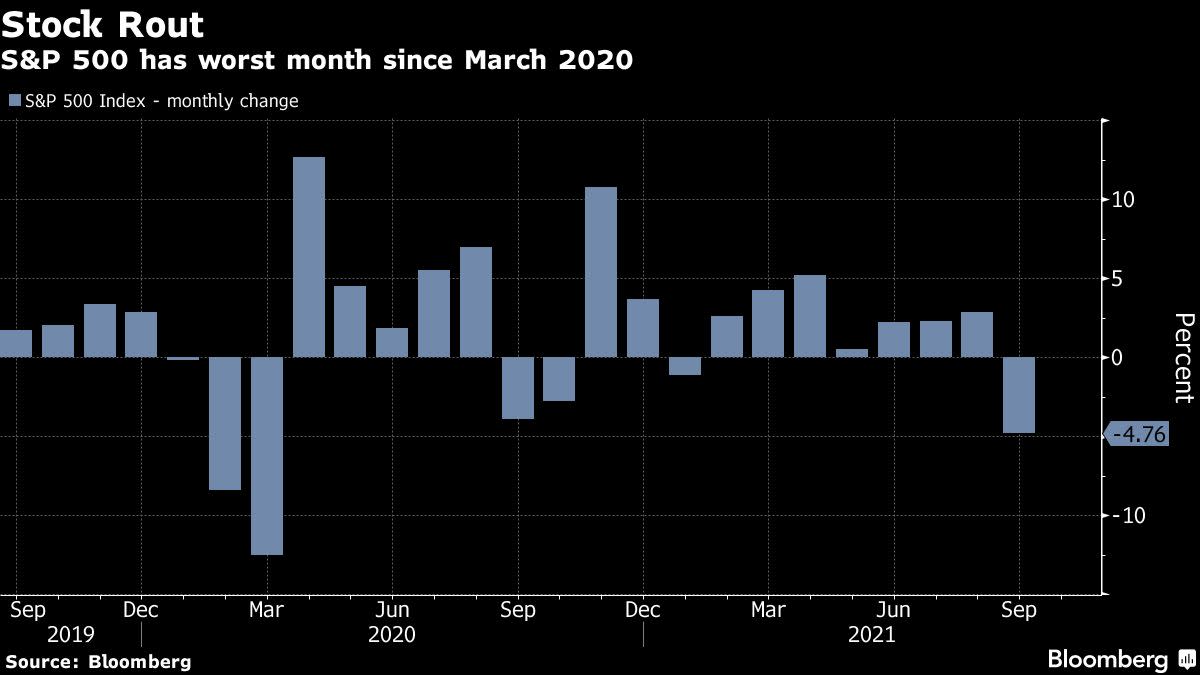Stocks, Futures Begin New Quarter on Risk-Off Note: Markets Wrap

(Bloomberg) — The first day of the final quarter of 2021 failed to bring cheer to investors who balked at the growing wall of worry from Federal Reserve tapering to stagflation and setbacks for U.S. President Joe Biden’s big spending plans.
Most Read from Bloomberg
Futures on the S&P 500 and Nasdaq 100 indexes lost 0.4% each after the underlying gauges ended September with the biggest slides since March 2020. The U.S. dollar caught a haven bid, inching closer to an 11-month high. European stocks headed for the biggest weekly plunge since January.
As investors brace for the Fed to wind down its stimulus, fears are mounting about slowing economic growth, elevated inflation, supply-chain bottlenecks, a global energy crunch and regulatory risks emanating from China. A short-term deal that averted a U.S. government shutdown was outweighed by concern the crisis could return in weeks and also delay Biden’s $4 trillion fiscal plan.
“A rocky start to the quarter is inherited from the wobble in U.S. equities amid a patchwork approach to avoiding a fiscal cliff conspiring with rising fears of inflationary shocks accentuated by the scramble for energy,” said Vishnu Varathan, head of economics and strategy at Mizuho Bank Ltd. “The threat is not merely interrupted growth/recovery but rather self-inflicted pain amplification between U.S. fiscal fumbles and China’s regulatory agitation.”
Europe’s Stoxx 600 gauge fell 0.8% as 19 of its 20 industry subgroups posted declines. A continent-wide energy crunch and stretched valuations contributed to the risk-off mood. Gambling provider Kindred Group Plc slumped as much as 8.6% after ceasing services to Dutch citizens.
OIl fluctuated between gains and losses. West Texas Intermediate futures failed to hold above the $75-per-barrel mark, but was still on course for a sixth weekly gain as China ordered its state-owned companies to secure energy supplies at all costs.
Political wrangling in Washington is threatening to push the U.S. into default and force President Joe Biden to scale back his spending agenda. House Speaker Nancy Pelosi was pressing ahead with a vote on a bipartisan infrastructure bill, even though progressive Democrats said they have the numbers to stall it until the Senate agrees on a more expansive tax and spending package.
Shares slumped in Japan and Australia, and a gauge of Asian stocks hit its lowest in more than a month. China began a week-long holiday and Hong Kong’s market was shut Friday.
Treasuries were steady, with the 10-year yield holding below 1.50%. Bitcoin extended recovery, trading around $44,600 apiece.
Here are some events to watch this week:
-
Univ. of Michigan sentiment, ISM manufacturing, U.S. construction spending, spending/personal income, Friday
For more market analysis, read our MLIV blog.
Some of the main moves in markets:
Stocks
-
The Stoxx Europe 600 fell 0.8% as of 8:36 a.m. London time
-
Futures on the S&P 500 fell 0.4%
-
Futures on the Nasdaq 100 fell 0.4%
-
Futures on the Dow Jones Industrial Average fell 0.5%
-
The MSCI Asia Pacific Index fell 1.2%
-
The MSCI Emerging Markets Index fell 0.6%
Currencies
-
The Bloomberg Dollar Spot Index was little changed
-
The euro was little changed at $1.1586
-
The Japanese yen was little changed at 111.25 per dollar
-
The offshore yuan rose 0.2% to 6.4358 per dollar
-
The British pound fell 0.1% to $1.3460
Bonds
-
The yield on 10-year Treasuries advanced one basis point to 1.50%
-
Germany’s 10-year yield declined one basis point to -0.21%
-
Britain’s 10-year yield was little changed at 1.02%
Commodities
-
Brent crude fell 0.3% to $78.06 a barrel
-
Spot gold fell 0.2% to $1,753.55 an ounce
Most Read from Bloomberg Businessweek
©2021 Bloomberg L.P.




